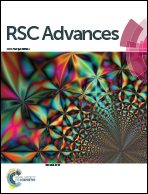A binder free synthesis of 1D PANI and 2D MoS2 nanostructured hybrid composite electrodes by the electrophoretic deposition (EPD) method for supercapacitor application†
Abstract
A facile, binder-free approach is applied, along with the electrophoretic deposition (EPD) method, to fabricate large-scale, hybrid 2D MoS2 nanosheets and 1D polyaniline (PANI) nanowires based electrodes on a conducting substrate for supercapacitor electrode material. The entire substrate surface is uniformly decorated by electrophoretically assembled MoS2 2D nanosheets and 1D nanowires of PANI, revealed by structural and morphological analysis. The electrochemical capacitive measurements of the MoS2/PANI hybrid electrode exhibit a specific capacitance of ∼485 F g−1 at a low charging–discharging current density (1 mA cm−2). The MoS2 : PANI composition ratio was varied as 1 : 1, 1 : 2 and 1 : 3 to achieve high supercapacitive performance. The maximum supercapacitive performance (∼812 F g−1) was obtained for a 1 : 2 ratio of MoS2 and PANI, with high energy density (112 W h kg−1) and power density (0.6 kW kg−1). Synergistic interactions between conductive 1D PANI and 2D MoS2 nanosheets with high surface area lead to a high supercapacitive performance. A binder approach to the direct synthesis of hybrid electrode by the EPD method eradicates the drawbacks offered by conventional electrodes prepared by the general slurry coating technique with resistive binders.


 Please wait while we load your content...
Please wait while we load your content...